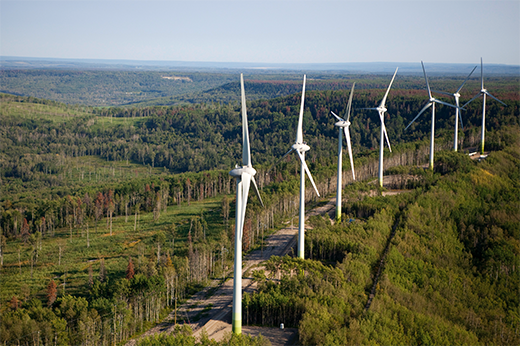
Canada’s energy system: your questions answered
Before and during our webinar overview of Canada’s electricity system—featuring our President, Sean Drygas, and Kathleen Gnocato, Director of Strategy & Product Development at MaRS Discovery District—we were blown away by all the thoughtful questions we received. It’s clear that Canadians care about where their power comes from, and what impact it has on the environment. Since there’s only so much we can cover in an hour, we’ve answered a few additional questions here. Kathleen considered these questions through the lens of her role at the MaRS Discovery District, which supports 1400+ Canadian ventures, including Cleantech ventures focused on addressing several of the issues raised. Her answers highlight a few emerging Canadian technologies that demonstrate what is possible. If you missed the webinar, you can watch the recording below:
Question: How can we influence a transition towards a renewable electricity grid on an individual scale? Is there a way we can “vote” with our dollars, such as by installing solar panels on the roof of our house?
Sean Drygas: That’s why Bullfrog was started: to give individuals a choice in their energy supply. When someone bullfrogpowers their home, they’re doing more than shrinking their personal carbon footprint—they’re increasing demand for renewable energy and encouraging the development and expansion of clean energy projects. They’re also sending a message to business leaders, policymakers, and their peers about the importance of green energy. It may seem like an individual can’t make a difference, but you’re far from alone in wanting a renewably powered future. And the more voices we add to the chorus, the better!
Installing solar panels on your roof would be another way to vote with your dollars, but it would require more dollars. For example, onsite solar at a residential scale in Ontario will usually cost two to three times more than grid power. You can have the same carbon impact for much less money by choosing solar and wind power produced at scale and delivered through the grid, via Bullfrog.
We offer solar to commercial customers today because for those with larger, flat roofs it can be competitive with utility costs. When the day comes that the same is true for residential-scale solar, we’ll happily provide that solution as well.
Question: What’s your take on hydrogen power?
Kathleen Gnocato: Hydrogen is emerging as a potential solution for hard-to-decarbonize sectors like industrial processes and freight. Green hydrogen remains a challenge to produce economically, as it’s not cost competitive with alternatives. But with sufficient capital and policy support, it’s expected to decline in price rapidly over the next 20 years. Here are a few companies to keep an eye on:
- Proton Technologies is developing a scalable solution to produce net-zero emission hydrogen from oil wells. The company has patented a method of igniting an oil well and using a palladium alloy filter in the wellbore that traps the carbon emissions in place while allowing pure hydrogen to flow to the surface. A pilot is underway in Saskatchewan and there’s significant interest from other oil and gas producers.
- Planetary Hydrogen is using its Ocean Air Capture technology to produce hydrogen with negative emissions. They’re in the early stages of technology development.
- Ionomr is developing an advanced ion-exchange membrane to improve the efficiency of electrolyzers and hydrogen fuel cells, a key barrier to low-cost green hydrogen production and utilization. The company raised a seed round last year and applies its material innovation to improve the stability, lifetime, and performance of electrolyzers and fuel cells.
Question: When you say “clean” electricity, are you referring only to carbon emissions?
Sean: At Bullfrog we look at the bigger picture—outside of just carbon emissions—when it comes to our energy sources. We consider factors including environmental and community impacts, air quality, and waste generation. That’s why Bullfrog has never sourced biomass-generated electricity—although it’s usually considered carbon neutral, the soot and other air quality impacts are too significant for us to consider it “clean.” In a similar vein, we don’t source nuclear power because of the radioactive waste it generates.
We only source from facilities that have received EcoLogo® certification for their reduced environmental impact. For example, the low-impact, EcoLogo®-certified hydro facilities we choose don’t adversely affect the environment and protect against biodiversity loss.
Question: How can individuals help shrink their carbon footprint through energy efficiency?
Kathleen: EnergyX offer an advanced energy audit solution and consumer platform that enables homeowners to make energy retrofits. Their software as a service (SaaS) platform is licensed by utilities to improve participation in utility programs, as many utilities struggle to effectively engage their customer base. Their solution focuses on addressing the low-hanging fruit of energy retrofits with automatic energy assessments of building stock—focusing on changing buildings, not behaviour.
Question: Are the electrical exports from Quebec to the USA committed over a long term? Is there room for Ontario to increase its imports from Quebec (at the expense of exports to the USA)?
Sean: Quebec does have a 20-year contract to supply 800MW to New York through to 2030. But as their continued efforts to grow US exports shows, there is capacity to grow supply to Ontario if the province is a willing buyer and adequate transmission can be constructed. The current interchange capacity between the two provinces is 2,700MW.
Right now, Ontario and Quebec have an agreement that allows for seasonal capacity sharing—Quebec has excess capacity during the summer and greater need in the winter, while Ontario’s is generally the opposite. These exchanges could be increased to help reduce the need for natural gas in Ontario, which would reduce the emissions from the grid.
What’s next for Canada’s energy system?
As Sean said in our webinar, we need to move quickly to non-emitting energy sources. Given Canada’s resources, there’s nowhere else in the world that’s better positioned to get to a 100% renewable grid. The opportunity is here—let’s go after it.